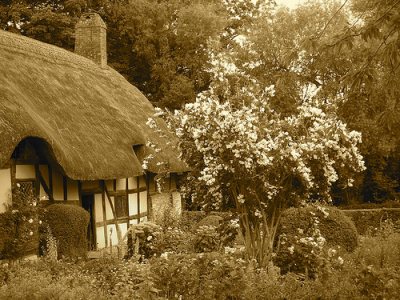
History of cottage gardens
 The
cottage garden arose naturally over the last half millenium as British
peasants planted gardens around their small houses. These were
hard-working laborers who didn't have the time or energy to spare for
mere prettiness, so they planted large vegetable, herb, and fruit
gardens, interspersed with a few flowers. The cottage garden
traditionally held a pig sty, a chicken coop, and bee hives as well to
round out the cottager's fare.
The
cottage garden arose naturally over the last half millenium as British
peasants planted gardens around their small houses. These were
hard-working laborers who didn't have the time or energy to spare for
mere prettiness, so they planted large vegetable, herb, and fruit
gardens, interspersed with a few flowers. The cottage garden
traditionally held a pig sty, a chicken coop, and bee hives as well to
round out the cottager's fare.
Around the end of the
eighteenth centuries, these poor peasants were
joined by the first wave of back-to-the-landers. Members of the
gentry began to idealize the cottage life and to create their own
cottage gardens. This is when the cottage garden began to veer
toward prettiness for its own sake, with scads of flowers often
replacing the original mixture of edible plants and animals.
In either case, though,
cottage gardens were beautiful. While the
vegetable patch was usually planted in bare, straight rows, the rest of
the garden consisted of plants pushed together until no soil could be
seen between the leaves. This informal clumping is the signature
feature of the cottage garden and can also be seen in the hodge-podge
of closely packed plants in Robert
Hart's forest garden.
| This post is part of our Cottage Garden lunchtime series.
Read all of the entries: |
Want more in-depth information? Browse through our books.
Or explore more posts by date or by subject.
About us: Anna Hess and Mark Hamilton spent over a decade living self-sufficiently in the mountains of Virginia before moving north to start over from scratch in the foothills of Ohio. They've experimented with permaculture, no-till gardening, trailersteading, home-based microbusinesses and much more, writing about their adventures in both blogs and books.
Want to be notified when new comments are posted on this page? Click on the RSS button after you add a comment to subscribe to the comment feed, or simply check the box beside "email replies to me" while writing your comment.
